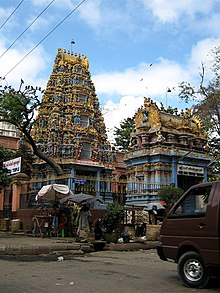
Back ভারতীয় বর্মী Bengali/Bangla هندیها در میانمار Persian भारतीय मूल के बर्मी लोग Hindi India Myanmar ID ជនជាតិឥណ្ឌាភូមា Cambodian ബർമ്മയിലെ ഇന്ത്യക്കാർ Malayalam பர்மிய இந்தியர் Tamil พม่าเชื้อสายอินเดีย Thai 印裔緬甸人 Chinese
| Total population | |
|---|---|
| 2,000,000 - 2,500,000 4.5% of the Burmese population | |
| Regions with significant populations | |
| Yangon, Mandalay, Taunggyi, Myitkyina | |
| Languages | |
| Burmese, Tamil , Telugu, Meitei (Manipuri[1][2]), Bengali, Gujarati, Odia, Hindustani | |
| Religion | |
| Majority: Hinduism Minority: Christianity · Buddhism · Islam · Sanamahism · Sikhism · Jainism | |
| Related ethnic groups | |
| Malaysian Indians, Singaporean Indians |

Burmese Indians are a group of people of Indian origin who live in Myanmar (Burma). The term 'Burmese Indian' refers to a broad range of people from South Asia, most notably from present-day countries such as India and Bangladesh. While Indians have lived in Burma for many centuries, most of the ancestors of the current Burmese Indian community emigrated to Burma from the start of British rule in the mid-19th century to the separation of British Burma from British India in 1937. During colonial times, ethnic Indians formed the backbone of the government and economy serving as soldiers, civil servants, merchants, moneylenders, mobile laborers and dock workers. A series of anti-Indian riots in the 1930s and mass emigration at the onset of the Japanese invasion of Burma in 1942 were followed in the 1960s by the forced migration of hundreds of thousands of ethnic Indians, exacerbated by internal conflict in Myanmar.[3]
Burmese Indians today are estimated to account for approximately 5% (about 2.0–2.5 million people) of the population of Burma and are concentrated largely in the two major cities (Yangon and Mandalay) and former colonial towns (Pyin U Lwin and Kalaw). They wield considerable influence and control over the Burmese economy and have a major socio-cultural presence within the country.[4][5] Amongst the well-known Burmese Indians is S N Goenka, a leading practitioner and teacher of vipassanā meditation and Helen, a well-known Bollywood film actress who is also of Anglo-Burmese descent.
- ^ "Manipuri language | Britannica". www.britannica.com. Retrieved 12 February 2023.
Manipuri language, Manipuri Meiteilon, also called Meitei (Meetei), a Tibeto-Burman language spoken predominantly in Manipur, a northeastern state of India. Smaller speech communities exist in the Indian states of Assam, Mizoram, and Tripura, as well as in Bangladesh and Myanmar (Burma).
- ^ "Meitei". Ethnologue. Retrieved 12 February 2023.
- ^ Egreteau, Renaud (June 2014). "The Idealization of a Lost Paradise: Narratives of Nostalgia and Traumatic Return among Indian Repatriates from Burma since the 1960s". Journal of Burma Studies. 18 (1): 137–180. doi:10.1353/jbs.2014.0002. S2CID 162378961.
- ^ Egreteau, Renaud (1 February 2011). "Burmese Indians in contemporary Burma: heritage, influence, and perceptions since 1988". Asian Ethnicity. 12 (1): 33–54. doi:10.1080/14631369.2010.510869. S2CID 143621311.
- ^ Medha Chaturvedi. "Indian Migrants in Myanmar: Emerging Trends and Challenges" (PDF). Mea.gov.in. Retrieved 17 August 2018.